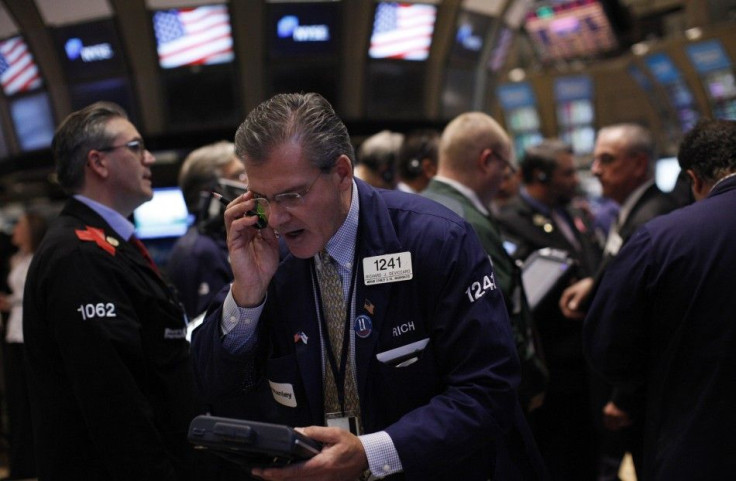US Stocks: Dow 13,000 - Market Top or Pit Stop?
Analysis

You can't blame investors for feeling a bit squeamish regarding deploying new money in the U.S. stock market these days, despite the Dow Jones Industrial Average's (DJIA) recent move past 13,000.
Lingering concern about Europe finances, along with below-trend U.S. GDP growth has created an uncertain U.S./Europe economic outlook. Where's the Dow likely to head in the next three months?
Each side -- the bulls and the bulls -- is trying to make a compelling case that the data support their view of the world: the current demarcation line is Dow 13,000 with another key battle line being the 12,800 support level below it and 14,000 resistance level above it.
The market's bulls argue that despite the fact that the U.S. economy still is not growing at robust rate -- it grew at a revised 3.0 percent rate in the fourth quarter, the expansion is accelerating, corporate earnings growth remains adequate-to-good, private sector lay-offs most likely have peeked, job growth is proceeding at an decent clip (more than 200,000 new jobs per month), the worst U.S. financial and economic news probably is over, and the Dow's recent push above 13,000 is a signal by institutional investors (IIs) that better days are ahead.
Conversely, the market's bears argue that the U.S. workforce is still woefully too small, with stagnant median incomes in many job classifications, and the nation's job deficit remains staggering -- about 10.5 million full-time jobs -- at minimum. Further, that ongoing buzzing mosquito called Europe government bonds, or sovereign debt -- means the Dow this spring is sending a false signal, and is likely to move decisively lower in the summer. What's more, although it's only March, you can hear those market bears yelling, Sell in May, and go away.
Cross-Methodological Analysis
Let's do a condensed, cross-methodology analysis to see if we can arrive at an informed investment decision / conclusion regarding where the Dow is headed, near-term.
Technical Indicators: Slightly Bullish. The Dow is above the 50-day (12,786) and 200-day (12,033) moving averages -- which is bullish. The 50-day is also substantially above the 200-day -- a golden cross -- and if that trend continues it's indicative of market strength. However, buying pressure as measured by the MacD Histogram has been modest, which is bearish. However, the Dow, as noted, did hold support at/near 10,700 this past week. Meanwhile, the Relative Strength Index (RSI) is overbought at 71, but history tells that markets can be overbought and remain overbought (or oversold) for a months, even quarters.
Fundamental Indicators: Slightly Bullish. The fourth quarter 2011 earnings season turned out to be slightly better than expected. Initial jobless claims are now below 360,000 and are in a downtrend, auto sales are rising, housing starts rose to a 700,000-unit annual rate in January, up from a 627,000-unit annual rate in October, the manufacturing sector continues to expand, and consumer confidence is rising.
Shiller S&P 500 PE Ratio: Slightly Bearish. The ratio, created by Yale University economics professor Robert Shiller, is at 23.4. That's well above the roughly 130-year median of 15.8 and the mean of 16.4. That means the S&P 500 is currently somewhat expensive.
Monetary Policy: Bullish. Despite three phases of quantitative easing (QE, QE2, Operation Twist) by the U.S. Federal Reserve, inflation remains moderate, running at a 2.2 percent 12-month core rate, which excludes food and energy prices, and a 2.9 percent rate overall. That moderate inflation, combined with the output gap, means the Fed will at least continue to reinvest the proceeds of the second stage of its quantitative easing policy to help stimulate the economy, 'QE2,' through at least the start of the third quarter, and perhaps for longer. Also, the Fed, in its most recent statement said economic conditions are likely to warrant exceptionally low levels for the federal funds rate at least through late 2014.
Fiscal Policy: Bearish. Most recently, the U.S. Congress, due to the Tea party-pressured Republican majority in the U.S. House, implemented austerity measures too soon. Deficit reduction and weeding-out needless programs are laudable goals, but reducing the deficit too fast -- especially if spending cuts affect the social safety net -- reduces demand, and could very well increase social problems -- leading to even higher social costs down the road.
Credit Markets: Recovering, but still strained, with still too many small/medium-sized businesses arguing they're not getting the level of credit they need to expand operations. Home mortgage qualifications terms remain very high. Home mortgage rates, however, are at/near 50-year lows, at an average of 3.88 percent for a 30-year, fixed-rate mortgage, for home buyers with excellent credit.
However, Europe's sovereign debt situation remains clouded, and there could be more financial market ripples. The major question marks concern Italy's ability to implement austerity measures and Greece's ability to follow-through with outlined budget cuts, even with a bailout package in-place. There is also concern that a contracting Greek economy will hinder that nation's debt servicing capability. Portugal or Spain are also keeping investors awake at night: some analysts say each will require a bail-out. So far, each has said they will not need outside intervention funds.
Conclusion: The view from here argues that the outlook for U.S. stocks and the U.S. stock market is Slightly Bullish for at least the next three months -- through mid-June.
Given the above technical and fundamental indicators,a modest uptrend in the Dow would not be unreasonable.
However, the current stock market remains highly selective, and the bias is toward deploying capital obly in those clear-winner stocks.
--
© Copyright IBTimes 2024. All rights reserved.





















